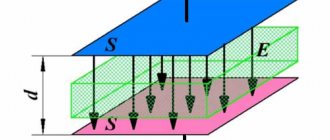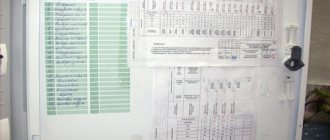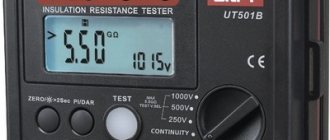During installation work, thermal insulation materials are secured using so-called mushrooms/umbrellas. They mean plastic fasteners with a flat round head. The design holds sheets of polystyrene foam, polystyrene foam, mineral wool well - the insulation can be attached to any wall/ceiling, be it brick, slag or ordinary concrete. The design of the element involves two parts - the central one (wedge) is made of metal; alternatively, it can be made of polyamide. Low-density polyethylene is used to make the dowel itself.
Disc-shaped dowel for fastening thermal insulation
Benefits of fungal fixatives
The widespread use of this option for fastening insulation is due to the following advantages:
- The wide cap ensures reliable fixation of any insulation. The inside of the cap is rough, which also further helps secure the material to the wall.
- The product implies the presence of an expansion washer, which can increase the contact area between the fungus umbrella and the insulating plate from 60 to 100 mm.
- The fastener has a long leg with good load-bearing capacity; it is also reliable due to spacers of three sections.
- Modern plastic dowels are a modified version of wooden plugs and do not have all the disadvantages that wood products have. In particular, plastic does not rot, does not suffer from mold, temperature changes, and this artificial material is cheaper.
- Reliability of fastening structures in the wall is ensured by screwing in a wedge - it pushes the walls of the anchor in all directions. This ensures the fixation of the dowel in the wall.
Types of dowels
All the needs of the construction market are met by three types of umbrella designs - their main difference is the anchor material.
Made from galvanized steel
Metal fungi
The metal dowel for attaching insulation is characterized by increased strength compared to its polymer counterparts. But its use is limited by the high thermal conductivity of the metal, which negatively affects the efficiency of the heat-insulating layer.
A steel dowel becomes a cold bridge, which reduces the overall thermal conductivity of the entire structure. Despite the presence of galvanization, models with a metal core are inevitably subject to corrosion, stains of which can appear even through the plaster on the facade, which spoils the entire exterior. The cost of a dowel with a metal nail is one and a half times more than a plastic one.
Made of plastic
Plastic umbrellas
Plastic elements for fastening insulation to the wall are made of polyamide, nylon and polypropylene. This determines their main advantage - their low price, while their strength characteristics are not up to par.
This type of fastener for thermal insulation can be used on concrete surfaces; alternatively, a plastic insulation fastener does a good job of fixing the mineral wool to a brick wall.
If the insulation is heavy enough and the wall is made of foamed concrete or has cavities, then it is better not to use plastic umbrellas.
With thermal head
Dowel with a thermal head
Models with a thermal head are superior in properties to metal dowels, since the head itself has low thermal conductivity and does not have the disadvantages inherent in metal products. The coating is made of impact-resistant polyamide, the thermal conductivity of which does not exceed the thermal conductivity of the insulation itself.
Since the metal is completely covered with a polymer cover, the design does not create cold bridges and does not reduce the overall thermal conductivity of the heat-insulating layer, and at the same time does not corrode, since its polymer is a reliable protection against moisture. The only drawback of such fungi is their high cost, which can be one and a half times higher than umbrellas with a steel anchor.
Dimensions of disc dowels
On the domestic market, manufacturers produce dowels according to GOST standards. Disc dowels have standard sizes. On sale you will find fasteners with lengths from 4 to 40 cm. If we consider metal dowels, their length varies up to 15 cm due to the large loads that they can withstand. There are extended type options up to 30 cm.
Fiberglass dowels are not inferior to metal dowels in their properties. They are quite durable and do not corrode and do not form “cold bridges”. Their length does not exceed 26 cm. If you choose a dowel with a rod longer than 140 mm, be prepared for installation difficulties. You will need to drive the dowel into the hole without breaking or deforming. Therefore, in this case, for deep connections it is better to choose dowels with a metal core.
Fungus sizes
The parameters of disc elements from different manufacturers may differ, since there is no single GOST that would regulate the size of such products.
You can only specify general values:
- the diameter of the mushroom cap for attaching the insulation varies from 45 to 90 mm;
- the diameter of the rod can be 8 or 10 mm;
- length range is 40-400 mm.
Dowels are available in different sizes.
Depending on the size, wedge material and wall material, the load on the fungus can range from 0.3 to 23 kN.
Types of fasteners
The shape of the product is determined by the specifics of the material being fixed: a light and loose heat insulator cannot withstand rigid fastening. The plastic pressure disk seems to support the insulation, but does not secure it.
However, the fasteners may differ in the design of the spacer part and the material of manufacture.
By design
There are 2 main fastening options.
- Non-expansion - the dowel is not equipped with hardware and does not need it. The fastener is inserted into the drilled hole through the insulating material. In a wall or ceiling, the dowel is held in place by structural protrusions.
- Expansion - in this case there is a nail or screw, which, when twisted or driven in, expands the body of the rod. The latter is held in the wall material due to friction.
The spacer version is more often used when fastening into dense materials - concrete, solid brick, while the non-spacer version is suitable for cellular concrete.
By material
To make the dowel, only plastic is used; the screw, if there is one, can be made of plastic or metal.
- Polyamide - or nylon. Durable lightweight material suitable for installation in any surface: brick, concrete, wood, hollow brick. The maximum load can reach 120 kg, the working load, respectively, is 30 kg.
- Polypropylene – has higher strength and hardness, the maximum load can reach 150 kg. Working for dense material will be about 40 kg.
- Glass fiber reinforced polyamide is a relatively new material, not much inferior in strength to metal, but without its disadvantage - high thermal conductivity.
The spacer rod can be made of the same plastic, including reinforced plastic, as well as metal. The bearing capacity of the latter is higher, but they somewhat compromise thermal insulation.
Used:
- galvanized steel – with a zinc thickness of at least 6 microns;
- Stainless steel - fasteners are much more expensive, but absolutely resistant to corrosion. Used in rooms with high humidity.
Read below about the design of dowels for attaching insulation to the wall and other surfaces.
Structural design
This refers to a combination of materials. There are 3 options:
- the dowel and the nail are made of the same plastic. It is not recommended to combine different plastics, since each material is characterized by its own coefficient of thermal expansion;
- plastic dowel and metal rod - the fastening strength is obviously higher and reaches 1.9 kN. However, metal conducts heat too well and forms a cold bridge in the heat-insulating layer;
- a plastic mushroom dowel for insulation and a metal rod with a thermal head - the nail head is covered with a nylon cap. The screw itself ends up inside the body of the rod. In this case, the problem of the cold bridge disappears.
Read below about the dimensions of the dowel-fungus for attaching insulation.
This video will tell you about the types of dowel-mushrooms for insulation:
Calculation of the number and length of dowels
When choosing the parameters for attaching the insulation to the wall, you can not pay attention to the load-bearing load, since due to its looseness, the density of the insulation is significantly less than the similar characteristics of the walls and ceiling.
This parameter is indicated in the documents for hardware, in particular, the pull-out load. In practice, this data is not used when choosing a product.
Parameters of IZL-T disc dowels
The following parameters are considered important:
- Length - when choosing the length, it is worth considering not only the thickness of the insulation and all other existing layers (glue, vapor and waterproofing, wall unevenness), the dowel must penetrate the wall to the minimum allowable amount. This value is different for each building material. The parameters of hollow and cellular concrete and brick are different - they are indicated in the certificate, which must be studied.
- The diameter of the disc element should be larger, the more loose the material is attached to the wall or ceiling. Dense foam plastic can be fixed with an umbrella with a small head, while mineral wool requires the largest discs.
- The number of umbrellas directly depends on the installation scheme - often 5 elements are required for one insulation plate - fastening is carried out in the corners and in the center. Well, if the insulation is attached to the facade, then the number of fungi is calculated based on the consumption per plate (1 sq. m.). The number of dowels in one plate directly depends not only on the size of the plate itself, but also on the wind load. Therefore, when installing insulation on a facade, from 7 to 9 fungi per square meter are used, which depends on the height of the building and the wind rose.
Subtleties and nuances of installing thermal insulation
The basic methods for installing thermal insulation for various materials, such as polystyrene foam, penoplex or expanded polystyrene, are identical. All work comes down to a general algorithm, which has several stages:
- Preparation of the surface on which the material will be installed.
- Installation of sheet thermal insulation on an adhesive solution.
- Fastening the panels with fasteners.
- Refinement of panel joints.
- Installation of waterproofing film.
- Covering the insulated surface with decorative materials.
All work must begin with preparing the working surface, removing old paint, wallpaper or plaster, as well as eliminating wall imperfections. Next, the selected material for insulating the room is placed on a specialized solution, which should not contain toluene and acetone. The gluing mixture must be distributed evenly over the entire area of the element being installed.
For additional fixation and to prevent the sheets from moving, the first level from the ceiling is secured to a metal profile. After the specified period for the adhesive solution to set, you can begin installing fastening mushrooms . When drilling holes for them, the diameter of the drill is used, which corresponds to the diameter of the fungus stem. The depth of the hole should exceed its length by ten millimeters so that any debris left after drilling does not interfere with the installation of the fasteners.
Construction standards, codes and regulations
If you pay attention to the current legislation in the construction industry, it establishes standards and requirements for the installation of thermal insulation:
- When installing thermal insulation indoors or on the facades of residential one-story buildings outside, per square meter of insulation surface, it is necessary to place 4 elements for fastening in the corners and one in the center.
- At the corners of the walls you will need to additionally secure it with 6 fasteners.
- Provided that the height of the facade is from 8 to 20 meters, 7 fasteners will be required at the edges and one in the center.
- During installation work at a height of over 20 meters, the rules require one square meter of insulated surface to be attached to 9 elements.
The best option is to strengthen fungi at the joints of foam panels or similar material, since this method optimizes the number of holes in the insulation, which will not therefore affect the overall effectiveness of such measures.
If the fastening element needs to be fixed on a metal surface, for example, on corrugated sheeting, then a self-tapping screw is attached to the dowel leg and, together with the insulation, is pressed against the wall, after which the self-tapping screw is screwed into the metal. The depth of screw tightening must be at least 15 millimeters. Next, the joints of the insulating panels are additionally glued with aluminum reinforcing tape, and the corner joints between the walls, ceiling or floor are sealed with polyurethane foam.
Calculation of the required number of fasteners
For high-quality and durable installation of insulation, you need to use fasteners made in accordance with GOST, but also not forgetting to calculate the required number of such parts. The following formula will help for this:
D = T + K + I + Z, where:
- T - Thickness of the installed insulation.
- K - Thickness of the adhesive layer used to fix the panels
- I - The depth of screwing the self-tapping screw into the wall is at least 45 millimeters.
- Z - Possible inclination of the wall relative to the vertical, this parameter is optional.
The length of the dowel anchor for use on brick or concrete walls must be at least 60 millimeters. And if the brick or foam concrete block is hollow, then in this case it is at least 100 millimeters.
When choosing a fungus for installing thermal insulation, you need to take into account the characteristics of the specific insulation and surface.
Installation of material using an umbrella
Installation work is an intermediate stage in finishing the interior or exterior. In any case, consider all the features of the surface to which the material is attached.
If the wall is loose and cracking, you need to take this into account when calculating the penetration depth or simply cut the wall down to a solid base.
Installation of the disc dowel is carried out as follows:
- We fix the insulating material with glue - this is true for polystyrene foam and polyurethane foam, and mineral wool is fixed with lathing.
- We mark the places for fastening on the plates, after which it is necessary to drill holes at the indicated points - their depth should be 15 mm greater than the calculated value. Spare centimeters are needed so that the dowel is guaranteed to fit to a certain depth, because there is no way to clear the hole of debris. The depth is calculated not from the surface of the insulation, but from the beginning of the wall surface.
- We insert the dowel into the hole, then drive in a wedge - the head of the metal pin must be closed with a cap.
Obviously, the process of installing disc elements for fixing thermal insulation materials is not difficult - this work can be handled without the appropriate skills and experience.










